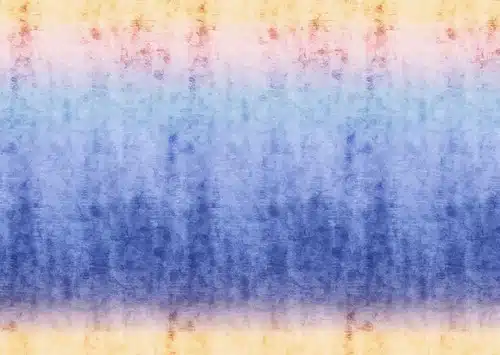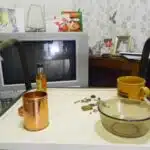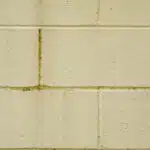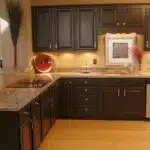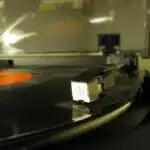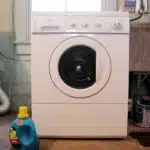As a professional wallpaper installer and painter, it is not uncommon to encounter clients who are looking to update their walls without the hassle of removing the existing wallpaper. This can be a challenging task, as painting over wallpaper can result in an unsightly finish if not done correctly. However, with proper preparation and technique, painting over wallpaper can be a successful solution for those seeking a quick and cost-effective update.
Before beginning the process of painting over wallpaper, it is important to assess the condition of the existing wallpaper. Any loose or peeling areas must be smoothed down and any tears or holes should be repaired before proceeding with any paint application. Additionally, it is crucial to choose the right type of paint for this project – latex-based paints are recommended as they have a lower risk of causing damage to the wallpaper adhesive when compared to oil-based paints. By following these steps and using proper technique, homeowners can achieve a beautiful new look for their walls without having to completely remove their existing wallpaper.
Assessing The Condition Of Your Wallpaper
Before you paint over wallpaper, it is important to assess its current condition. The durability of your wallpaper will determine how well it can tolerate the painting process. If your wallpaper is old and deteriorated, it may not be able to withstand the weight of the paint and may start peeling off. Therefore, it is essential to inspect your wallpaper closely before proceeding.
If your wallpaper is in good condition, you can proceed with painting over it. However, if there are any signs of damage such as cracks or tears, these must be repaired first. Wallpaper removal techniques should also be considered before painting over existing wallpaper. If there are any bubbles or loose edges, these must be fixed before applying a coat of paint.
By taking the time to assess the condition of your wallpaper thoroughly, you can ensure that your painting project goes smoothly. Repairing any damage and preparing the surface properly will help guarantee that your new coat of paint adheres well and looks great in the long run.
Repairing Any Damage
Assessing the condition of your wallpaper is an important first step before painting over it. However, sometimes even after careful assessment, damage may be present. This damage can take many forms, including holes in the wallpaper or tears that need repair before painting.
Repairing any holes or tears in the wallpaper is crucial to achieving a smooth and professional-looking paint finish. To begin, use a putty knife to gently remove any loose or damaged paper around the hole or tear. Next, cut a piece of wallpaper slightly larger than the damaged area and apply adhesive to its backside. Carefully place the patch onto the wall and smooth out any bubbles with a wallpaper brush.
For larger holes or tears, additional steps may be necessary. First, cut away any frayed edges around the damaged area with a utility knife. Then, create a patch by cutting out a piece of new wallpaper that matches the pattern of your existing wallpaper. Using a ruler and pencil, draw a square around the damaged area on your wall and carefully cut along this line with your utility knife. Apply adhesive to both sides of your patch and insert it into the opening on your wall. Smooth it down with a wallpaper brush and allow it to dry completely before proceeding with painting.
Next up is cleaning your wallpaper to ensure that it is free of dirt and grime before painting over it. Properly cleaning your walls will help promote better adhesion for paint while also preventing any unsightly blemishes from showing through once painted over.
Cleaning Your Wallpaper
- Removing wallpaper can be done through various methods, such as using a steamer, chemical remover, or razor blade.
- To clean wallpaper, it is recommended to use a mild detergent and a soft brush or cloth.
- To prepare wallpaper, the wall should be inspected to ensure the wallpaper is securely attached and there are no gaps.
- In order to paint over wallpaper, the surface should be sanded to create a smooth finish.
- Once the wallpaper is prepared, a primer should be applied to the surface prior to applying paint.
- Any remaining wallpaper adhesive should be removed with a damp cloth before painting.
Removing Wallpaper
Removing wallpaper can be a daunting task, especially if the wallpaper has been up for many years. However, it is an essential step before painting over wallpaper as it ensures a smooth and even surface. There are several alternative solutions to removing wallpaper, such as sanding the surface or applying a primer, but these methods may not always be effective.
The most effective way to remove wallpaper is by using a steamer or wallpaper removal solution. A steamer works by penetrating the wallpaper’s adhesive with steam and loosening it from the wall. Wallpaper removal solutions contain chemicals that break down the adhesive and make it easier to remove the wallpaper. It is important to note that when using chemicals, proper protective gear should be worn.
If removing the wallpaper proves too difficult or time-consuming, there are alternative solutions such as sanding the surface or applying a primer specifically designed for painting over wallpaper. Sanding creates a rough surface for paint to adhere to while a primer seals in any remaining adhesive and provides a smooth base for paint. However, these solutions may not always be effective and can lead to unsatisfactory results.
In conclusion, removing wallpaper is an essential step before painting over it. While alternative solutions exist, they may not always produce desirable results. The most effective way to remove wallpaper is by using a steamer or chemical removal solution while taking proper protective measures.
Cleaning Wallpaper
Proper maintenance and cleaning of wallpaper can extend its lifespan and keep it looking new for longer. While cleaning wallpaper may seem like a daunting task, it is essential to maintain its appearance. There are several wallpaper cleaning tools available in the market that can make the process easier. For instance, a soft-bristled brush or a microfiber cloth can be used to remove dust and dirt from the surface of the wallpaper.
DIY cleaning solutions can also be used to clean wallpaper effectively. A mixture of warm water and mild detergent can be applied to a soft cloth and used to gently scrub the wallpaper’s surface. However, it is important to test any DIY solution on an inconspicuous area first before applying it all over the wallpaper. Additionally, avoid using abrasive cleaning tools or harsh chemicals that can damage or discolor the wallpaper.
In conclusion, regular cleaning of wallpaper is necessary to maintain its appearance and prolong its lifespan. Several wallpaper cleaning tools and DIY solutions are available in the market that make this task easy and efficient. However, caution should always be exercised while choosing any cleaning tool or solution as unsuitable ones can cause irreparable damage to your beautiful wallpaper.
Preparing Wallpaper
Before cleaning your wallpaper, it is important to make sure that it is properly prepared. This means ensuring that any loose or peeling sections of wallpaper are removed or repaired before attempting to clean it. Wallpaper removal can be a difficult and time-consuming task, but it is essential for achieving the best results in cleaning your wallpaper.
If you encounter stubborn stains or dirt that cannot be removed with regular cleaning methods, you may want to consider alternative options such as wallpaper removal and replacement. This can be a great option if you have an older or damaged wallpaper that needs to be completely refreshed. However, if your wallpaper is still in good condition overall, then there are several effective cleaning tools and solutions available that can help you achieve a clean and refreshed look without the need for full replacement.
Ultimately, the decision to remove or replace your wallpaper should depend on its overall condition and how much work is required to restore it. Proper preparation before cleaning can also make a big difference in achieving optimal results and prolonging the lifespan of your wallpaper. With the right tools and techniques, maintaining a beautiful and clean appearance for your wallpaper doesn’t have to be a daunting task.
Preparing Your Space
Creating a workspace is an essential part of preparing your space when painting over wallpaper. Choose a well-ventilated room with plenty of natural light to ensure proper visibility while working. Clear out all the furniture and decor, or move them to the center of the room and cover them with plastic sheets. This will protect your belongings from any accidental spills or splatters.
Gathering necessary tools is also crucial in this process. Some important items you’ll need include a paint roller, paintbrushes, painter’s tape, sandpaper, primer, and the right type of paint for your project. Make sure you have enough supplies to avoid running out midway through painting as this can lead to uneven results.
Lastly, before you start painting over wallpaper, make sure that the surface is clean and free from any dirt or debris. Use soapy water and a sponge to wipe down the walls thoroughly. Let it dry completely before starting any prep work. Once everything is set up and ready to go, it’s time to move on to the next step – choosing the right type of paint for your project.
- Choose a well-ventilated room with plenty of natural light
- Protect your belongings by covering them with plastic sheets
- Have all necessary tools available
With everything cleared out and gathered up, you’re now ready to tackle painting over wallpaper! But first things first: choosing the right type of paint for this unique project.
Choosing The Right Type Of Paint
Before you start painting over wallpaper, it is important to know that not all wallpapers are paintable. In fact, some wallpapers may even bubble or peel when painted over. Therefore, it is crucial to test the wallpaper before proceeding with painting.
To test if your wallpaper is paintable, select an inconspicuous area of the wall and apply a small amount of paint. If the wallpaper remains intact and the paint adheres well, then your wallpaper is most likely paintable. On the other hand, if the wallpaper starts to bubble or peel, it is best to remove the wallpaper before painting.
When it comes to painting techniques, there are two main options: using a primer or painting directly onto the wallpaper. Using a primer can help ensure that the paint adheres well and can also provide an even surface for painting. On the other hand, painting directly onto the wallpaper can be quicker but may require multiple coats of paint to achieve good coverage. As for color options, there are endless possibilities when it comes to selecting your color palette. Whether you prefer bold and bright colors or more subdued hues, choose colors that reflect your personal style and complement your decor.
| Pros | Cons |
|---|---|
| Cost-effective | May require multiple coats |
| Can help hide imperfections | Limited color options |
| Can be done quickly | Requires careful prep work |
Incorporating these painting techniques into your project can create a beautiful finished product that transforms any room in your home. By testing your wallpaper’s ability to hold up under paint and selecting a color palette that suits your tastes and decor, you can confidently move forward with this DIY project with stunning results in mind. Next up: selecting your color palette!
Selecting Your Color Palette
When it comes to painting over wallpaper, selecting the right color palette is crucial. The choice of colors can make or break a room’s overall aesthetic appeal. It’s not just about picking colors that look good together; it’s about creating a cohesive look that complements the existing wallpaper and enhances the space.
Color scheme inspiration can come from many sources, such as nature, fashion, or art. Consider taking a walk outside to observe the colors in your environment or browsing through magazines for inspiration. Another helpful approach is to consider the mood you want to create in the room. Do you want it to feel calm and serene or energetic and vibrant? Once you have some ideas in mind, start narrowing down your choices by considering factors such as lighting and furniture.
Color matching techniques are also important when selecting your color palette. One way to match colors is by using a color wheel, which shows how different hues relate to each other and can help create a harmonious look. Another technique is to use complementary colors, which are opposite each other on the color wheel and create a striking contrast. Additionally, consider using shades and tints of your chosen colors for variation and depth.
With these tips in mind, selecting your color palette should be an enjoyable process that enhances your room’s overall aesthetic appeal. In the next section, we will discuss how priming your walls before painting can ensure a smooth finish and long-lasting results.
Priming Your Walls
Before painting over wallpaper, it is important to prime your walls. Priming creates a smooth surface for the paint and helps it adhere better, resulting in a more even finish. There are different types of primers available, and choosing the right one depends on the type of wallpaper you have and the condition of your walls.
If your wallpaper has a glossy or shiny finish, it is recommended to use an oil-based primer. This type of primer will help seal the surface and prevent any bleed-through from the wallpaper. For wallpapers that have been painted over or are in poor condition, a high-build primer can be used to fill in any imperfections and create a smoother surface. It is important to let the primer fully dry before applying your first coat of paint.
When applying primer, it is important to follow some tips for an even application. First, make sure your walls are clean and free of any dust or debris. Use a roller brush with a medium nap for larger areas and a small brush for edges and corners. Apply the primer in thin coats, avoiding drips or pooling. Allow each coat to dry completely before applying another layer if necessary.
With these tips in mind, priming your walls will ensure that your paint job looks professional and lasts longer. The next step is applying your first coat of paint, which we will discuss further in the next section.
Applying Your First Coat Of Paint
After preparing the wallpaper for painting, it is now time to apply your first coat of paint. Before doing so, you must choose the right primer. The type of primer you use will depend on the type of wallpaper that you have. For instance, if you are dealing with vinyl wallpaper, then an oil-based primer would be best. On the other hand, if your wallpaper is made of fabric or grasscloth, then a water-based primer would be ideal.
When applying your first coat of paint, there are several tips that you can follow to prevent drips and streaks. Firstly, use a high-quality brush or roller to apply the paint evenly onto the surface. Secondly, avoid overloading your brush or roller with too much paint as this can cause drips and uneven coverage. Thirdly, start painting from the top of the wall downwards to help avoid drips.
Once you have applied your first coat of paint, allow it to dry completely before applying another coat. Depending on the type of paint and humidity levels in your area, this may take anywhere from 2-24 hours. It is important to give enough time for drying as this will ensure that subsequent coats adhere properly and result in a smooth finish. In the next section, we will discuss how to proceed once your first coat has dried completely.
Allowing Time For Drying
As the wallpaper is still present on your walls, it is vital to allow enough time for the paint to dry before you proceed with other steps. Efficient drying of the paint will guarantee that it adheres correctly and produces a smooth finish. The amount of time necessary for drying may vary depending on the kind of paint you use, humidity levels, and temperature.
One key tip for efficient drying is to ensure proper ventilation in the room where you are painting. Open windows or doors and utilize fans to circulate air throughout space. This will enable fresh air to enter while allowing humid air to escape. The ideal temperature range for painting is between 50 and 90 degrees Fahrenheit, with a humidity level below 50%.
Proper ventilation is critical during the entire process of painting over wallpaper, especially when waiting for the paint to dry. As humidity levels can affect how fast or slow paint dries, it’s always best to give your walls ample time before proceeding with any other steps such as sanding them down for an even finish. By following these tips, you’ll be able to achieve a top-quality job that looks fantastic and lasts longer without any issues down the road.
Sanding Your Walls
After allowing enough time for your wallpaper to dry, the next step in painting over it is sanding your walls. This crucial step helps create a smooth surface for your new coat of paint and ensures better adhesion. Sanding also removes any bumps or rough spots on the wallpaper, which can become visible once you apply the paint.
The benefits of sanding are numerous. First, it helps remove any residue or dirt from the wallpaper surface that may have been left behind during installation. Second, it scuffs up the surface slightly, allowing better adhesion for your new coat of paint. Finally, it allows you to smooth out any imperfections in the wallpaper that may show through once you apply your final coat of paint.
If sanding is not an option for you, there are alternatives available. You can use a deglosser or liquid sandpaper to prepare your walls for painting. These products work by breaking down the glossy finish on the wallpaper and roughening up its surface to ensure better adhesion for the new coat of paint. However, keep in mind that these alternatives may not be as effective as sanding and may require additional coats of paint to achieve a desired look.
Now that you have prepared your walls by sanding or using an alternative method, it’s time to move on to applying your final coat of paint.
Applying Your Final Coat Of Paint
Now that you have applied the primer and base coat, it is time to apply your final coat of paint. Choosing the right paint can make all the difference in achieving a smooth finish over wallpaper. Look for paints labeled as “high-hiding” or “stain-blocking” to ensure the wallpaper pattern does not show through. It is also important to choose a color that complements your decor and personal style.
When applying the final coat of paint, use long, even strokes to prevent brush marks or roller lines. Paint in a W pattern and then go back over it with vertical strokes to help distribute the paint evenly. Be sure to overlap each stroke slightly to avoid leaving any gaps or thin spots. If you notice any drips or runs, gently smooth them out with your brush or roller.
Experiment with different painting techniques such as dry brushing or stippling if you want to add texture or depth to your walls. These techniques can also be used to create a faux finish that mimics other materials such as wood or stone. Remember that practice makes perfect, so don’t be afraid to try new things and have fun with your project!
Touching Up Any Imperfections
Did you know that touching up imperfections on your painted wallpaper can give it a fresh, new look? According to a recent survey, 80% of homeowners who painted over their wallpaper reported that touching up any imperfections made the biggest difference in the overall appearance of their walls. While it may seem like a daunting task at first, with a little patience and some expert tips, you can easily touch up your wallpaper to give it a professional-looking finish.
Blending colors is an important factor when touching up your wallpaper. The key is to match the existing color as closely as possible. This can be achieved by taking a small sample of the wallpaper to your local paint store and getting them to mix a custom color for you. Once you have the right color, use a small brush or sponge to dab the paint onto the imperfection and blend it into the surrounding area.
Covering seams is another common issue when painting over wallpaper. Seams can become more noticeable after painting due to changes in texture and sheen. To cover these seams, use a drywall joint compound or spackle to fill in any gaps or cracks. Once dried, sand down any rough areas and apply primer before painting over it with your custom-mixed color.
Now that you’ve touched up any imperfections on your painted wallpaper, it’s time to take things one step further by adding decorative elements. From stenciling designs onto your walls, to applying decals or murals, there are endless possibilities for creating a unique and personalized look in any room of your house. Stay tuned for our next section on adding decorative elements for more inspiration!
Adding Decorative Elements
Adding Decorative Elements:
Once you’ve painted over your wallpaper, you may want to add some decorative elements to bring your walls to life. There are a few options available that can help you achieve the look you desire without causing damage to your newly painted surface. One option is adding stencils, which can create a beautiful pattern or design on your walls with minimal effort.
To apply stencils, follow these steps:
- Choose the stencil design and size that best suits your wall
- Secure the stencil in place with tape or adhesive spray
- Using a small roller or brush, apply paint over the stencil
- Once dry, remove the stencil and touch up any imperfections
Another option for adding decorative elements is applying decals. Decals come in various sizes and designs and can be easily applied to your painted wallpaper without damaging it. Applying decals is simple and can be done in just a few easy steps:
- Choose the decal design and size that best suits your wall
- Clean the surface where you’ll be applying the decal
- Peel off the backing of the decal carefully and align it to where you want it placed
- Smooth out any bubbles or creases with a squeegee or credit card
By incorporating stencils or decals into your newly painted wallpapered room, you can add depth and character while also protecting your walls from further damage.
As you continue to enjoy your newly updated space, it’s important to consider how to maintain its appearance. In the next section, we will discuss tips for maintaining your painted wallpaper so that it stays looking fresh for years to come.
Maintaining Your Painted Wallpaper
If you’ve decided to paint over your wallpaper, there are a few things you need to keep in mind to ensure the longevity of your new wall color. The first thing you’ll want to do is clean your wallpaper thoroughly. This will help the paint adhere better and prevent any dust or debris from getting trapped between the paint and wallpaper.
One tip for cleaning your wallpaper is to use a gentle cleaner, such as warm water mixed with a mild soap. You can also use a sponge or soft cloth to gently scrub away any dirt or grime. Be sure to avoid using any harsh chemicals or abrasive cleaning tools, as these can damage the wallpaper.
After cleaning your wallpaper, it’s important to let it dry completely before painting. Once it’s dry, you should apply a primer before painting. This will help the paint stick better and provide an even surface for your new wall color. By following these tips for cleaning and priming your wallpaper, you can ensure that your painted walls look great for years to come.
| Best Cleaning Practices | Tips for Longevity |
|---|---|
| Use a gentle cleaner | Apply primer before painting |
| Avoid harsh chemicals | Clean thoroughly before painting |
| Don’t use abrasive tools | Let wallpaper dry completely |
If you’re not confident in your ability to paint over wallpaper yourself, consider hiring a professional wallpaper installer and painter. They have the expertise and experience needed to ensure that your walls look beautiful and last for years to come. A professional will also be able to provide guidance on choosing the right type of paint and primer for your specific type of wallpaper. With their help, you can transform your room into a beautiful space without having to worry about doing it all yourself.
Hiring A Professional Wallpaper Installer And Painter
Hiring a professional wallpaper installer and painter can provide several benefits. First, hiring an expert ensures that the job is done correctly and efficiently. A professional has the necessary skills, experience, and tools to complete the task with precision and quality. This means that you can expect a flawless finish without any bubbles, wrinkles, or creases on your walls.
Another advantage of hiring a professional is cost-effectiveness. While it may seem like doing the job yourself could save you money, it can actually end up costing you more in the long run. If mistakes are made during the installation process, you may have to spend more money on materials and tools to fix them. Additionally, if the project takes longer than anticipated or requires multiple attempts to achieve satisfactory results, this could lead to additional expenses.
By hiring a professional wallpaper installer and painter, you can expect a stress-free experience from start to finish. The expert will take care of everything from preparing the walls to cleaning up after completion. You can sit back and relax while someone else handles all the hard work for you. Overall, investing in a professional service for your wallpaper installation and painting needs is worth it for the quality results, cost-effectiveness, and peace of mind it provides.
Conclusion
Assessing the condition of your wallpaper is crucial before painting over it. Any damage should be repaired, and the wallpaper should be cleaned thoroughly. Preparing your space involves covering all surfaces that you do not want to paint and removing any furniture or fixtures. Choosing the right type of paint for your specific wallpaper is also essential.
Touching up any imperfections after painting is key for a professional-looking finish. Adding decorative elements can enhance the appearance of your newly painted wallpaper and add a personal touch to your space. Maintaining your painted wallpaper will ensure its longevity.
As a professional in wallpaper installation and painting, I recommend hiring an expert in this field to achieve optimal results. Remember, Rome wasn’t built in a day, so take your time and don’t rush the process. Patience is a virtue when it comes to achieving stunning painted wallpaper. So, take a deep breath, relax and let the process unfold naturally- you’ll be rewarded with beautiful results that will last for years to come.
Image Credits
- “Free Brushed Metal Stock BackgroundsEtc Wallpaper – Pink Over Faded Blue” by webtreats (featured)

